
 |
A simple search for a new case leads off into the twisted and entangled roots of the publishing and electronic dissemination of federal court opinions - Google AltLaw Pacer ECF FindLaw - and Docket Numbers in citations redux.
[pre-released September 23, 2007, revised and edited October 12, 2007]
[Addenda-April 26, 2008 - Professor Peter Martin has published an article initially dated October 4, 2007, Finding and Citing the “Unimportant” Decisions of the U.S. Courts of Appeals" at Legal Information Report 2007-1, an on-line journal he has started, which covers some of the points herein.]
After reading about a recent United States Court of Appeals antitrust opinion in an on-line newsletter, I wanted to read the opinion, as well as the United States District Court opinion below, and decided to search for the opinions using public free resources on the Internet.
The newsletter had no link to the text of the opinion and no citation. There were three clues: - the case was known as the "Elevator Antitrust Case ", it was a Second Circuit case, and the article implied that the opinion was decided September 7, 2007. No docket number was provided in the newsletter, nor any citation to Westlaw or Lexis.
Armed with these clues, I went off to search for the opinion and the district court opinion below, starting with official court sites.
This quest was really an example of looking for an authentic source of a known judicial opinion, based upon whatever identifying information available. This is a distinct search objective, distinct from searching for other judicial opinions citing the opinion or articles or blogs mentioning the opinion. It is also a search objective distinct from searching for the needle in the haystack within judicial opinions. John Batelle's book Search cites a study by Andrei Broder that 25 percent of searchers were looking for "a specifc web site I already have in mind." In the legal sphere, I would warrant that 25 per cent of seraches are looking for a specific judicial opinion. So, a host of opinions that cannot serve up the opinion to searches is not meeting a basic objective.
In this tour of search sites and court sites looking for information about this one antitrut case, it was surprising how many anomalies surfaced.
This started off with a simple quest, which then turned into a serendipitous search through Google, Lexis, ECF sites, Pacer Sites, court sites, AltLaw and others. If these comments ramble, this was the way I actually searched for the information. This quest provided support to the following conclusion, observations and hypotheses:
[docket number] second circuit
or
[name of first party in case] second circuit
site:www.ca2.uscourts.gov
site:AltLaw.org
I first went to the new AltLaw.org hosted out of Columbia Law School, and only a few miles uptown from the Federal Court House in Foley Square in Manhattan. Albeit Altlaw is in Beta -but I assumed they would have the Elevator Antitrust opinion since is is so recent. [Editor's note - AltLaw was alerted to this anomaly when this article was pre-released, but the anomaly remains.]
I first searched at AltLaw for "Elevator Antitrust" across all cases for any case having both words - no result. Next, I restricted a search to the Second Circuit. No results. Then I searched for "Twombley", a line of cases I thought might be cited, and which resulted in a recent Supreme Court case, Bell Atlantic Corp. v. Twombly, ___ U.S. ____, 127 S. Ct. 1955, 2007 U.S. Lexis 5901 (May 2007). Again no results (perhaps because the exact spelling is Twombly - when I tried the search Twombley Antitrust in Google, the response was "Did you mean: twombly antitrust" which is what I meant - but, many writers misspelled the name.)
I knew that Altlaw was being frustrated by the Second Circuit web sites. It having been years (1997) since HyperLaw had last batch downloaded from the Second Circuit, I decided to search the Second Circuit official site. Once there, I could see that the Second Circuit might be the source of the Altlaw problems.
First, the Second Circuit has no FTP access to its opinions, a sine qua non for any Court that is fully committed to public access to the law. Although the the Fifth Circuit like the Second Circuit, also uses ISYS for searching opinions as the Fifth Circuit provides an FTP site which permits wholesale downloading of all of its cases. The Second Circuit requires bulk downloaders, including public interest sites like AltLaw, to penetrate the ISYS search engine with complex crawlers. The Second Circuit provides scant metadata [this is a problem of the Second Circuit's incomplete implementation of ISYS, not a problem with this excellent search engine.). So, the Second Circuit is a problem indeed. On the positive side for the Second Circuit, despite a complex URL, opinions, once found, are linkable from the outside and the Published opinions are indexed by Google and Yahoo.
Before discussing our search for the Elevator Antirust case, this investigattion showed that it appears that the unpublished opinions on the Second Circuit site are indexed by Google, although they are indexed if on AltLaw. In each of its unpublished opinions, the Second Circuit includes this warning:
RULINGS BY SUMMARY ORDER DO NOT HAVE PRECEDENTIAL EFFECT. CITATION TO SUMMARY ORDERS FILED AFTER JANUARY 1, 2007, IS PERMITTED AND IS GOVERNED BY THIS COURT’S LOCAL RULE 0.23 AND FEDERAL RULE OF APPELLATE PROCEDURE 32.1. IN A BRIEF OR OTHER PAPER IN WHICH A LITIGANT CITES A SUMMARY ORDER, IN EACH PARAGRAPH IN WHICH A CITATION APPEARS, AT LEAST ONE CITATION MUST EITHER BE TO THE FEDERAL APPENDIX OR BE ACCOMPANIED BY THE NOTATION: “(SUMMARY ORDER).” UNLESS THE SUMMARY ORDER IS AVAILABLE IN AN ELECTRONIC DATABASE WHICH IS PUBLICLY ACCESSIBLE WITHOUT PAYMENT OF FEE (SUCH AS THE DATABASE AVAILABLE AT HTTP://WWW.CA2.USCOURTS.GOV), THE PARTY CITING THE SUMMARY ORDER MUST FILE AND SERVE A COPY OF THAT SUMMARY ORDER TOGETHER WITH THE PAPER IN WHICH THE SUMMARY ORDER IS CITED. IF NO COPY IS SERVED BY REASON OF THE AVAILABILITY OF THE ORDER ON SUCH A DATABASE, THE CITATION MUST INCLUDE REFERENCE TO THAT DATABASE AND THE DOCKET NUMBER OF THE CASE IN WHICH THE ORDER WAS ENTERED.
It is suggested that if the Second Circuit would open up its unpublished opinions to Google and require the docket number in any citation, the problem would be over - and the best solution would be to open up its unpublished opinion directories to FTP retrieval as well. The parties would have no problem obtaining access to Second Circuit unpublished opinions.
It is my understanding that for the Google to index Second Circuit documents, the Second Circuit had to submit the URL's to Google. I am not sure Google is able to locate the URL's by going through the ISYS engine, without extra effort, although I may not be correct.
To continue with my quest, I guessed that the best way to find the Elevator Antitrust opinion would be to check the Second Circuit docketing systems (I know now that I should have Googled first.). So, I then went to the Second Circuit Dockets tab http://www.ca2.uscourts.gov/docketsearch.htm and entered "Elevator Antitrust" and nothing was returned. Odd. This was on a page labeled "5 Digit Dockets." So, I tried again with just the word "Elevator" and received 152 hits. I checked a couple, but did not want to check them all.
The ISYS listing retrieved, incidentally, was meaningless, providing neither the name of the case nor the date of the case - one wonders why the search result could not provide more useful information.
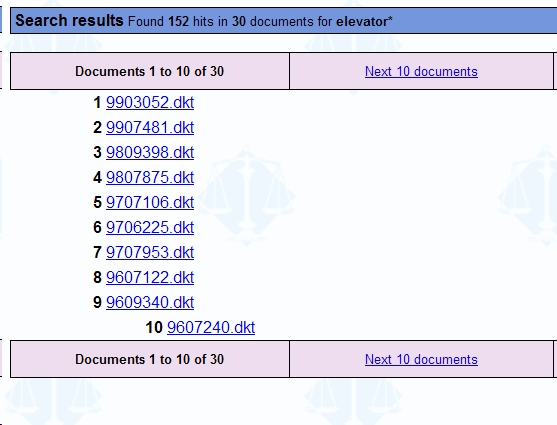
I then decided to try the search on the Court's Pacer system at http://pacer.ca2.uscourts.gov, which, also, has docketing information. Pacer was the initial federal court system to provide docketing information. At the district court level, this system has been replaced by the Electronic Case Filing System which makes dockets and Acrobat files of the filings available. A password is needed for Pacer and ECF. For some reasons, ECF has not been implemented at the Courts of Appeals.
I then received this screen:

But no results:
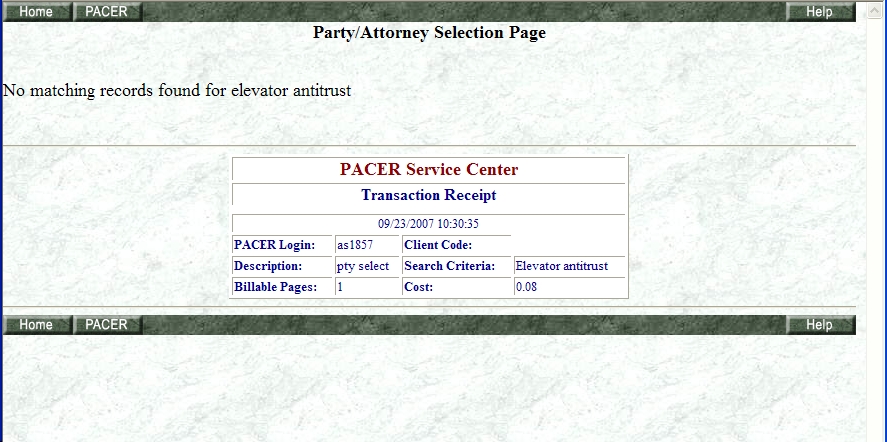
So, I then moved to the Decisions/Opinions Page at http://www.ca2.uscourts.gov/opinions.htm - surely I would find the opinion there and using the court's ISYS search engine, searched for "elevator antitrust" and, yes indeed, found the opinion. Note however that the search result, due to the poor implementation of ISYS, does not indicate the name of the case - fortunately, there was only one case shown.

I downloaded the pdf file using this link on the page using this link.
http://www.ca2.uscourts.gov:8080/isysnative/RDpcT3BpbnNcT1BOXDA2LTMxMjgtY3Zfb3BuLnBkZg==/06-3128-cv_opn.pdf#xml=http://10.213.23.111:8080/isysquery/irl3f12/1/hilite
What one notices here is that the Second Circuit is using the ISYS Search Engine which provides this elaborate link. Without the "hilite" command, the simpler link is:
One wonders why the Second Circuit could not provide a simple link such as and use a redirection scheme to find the file such as:
www.ca2.uscourts.gov/06-3128-cv_opn.pdf
The problem is that if the Second Circuit decides to stop using ISYS, or the ISYS link format changes, these links would not work.
At the very least, the Second Circuit root servers at www.ca2.uscourts.gov should redirect any request including 06-3128-cv_opn.pdf to this file. This could be accomplished now without much ado and most commercial web site today have the ability to perform this redirection. Ineed, web server programmers could fix implement this readily.
Having downloaded the opinion, it is useful to inspect the format of the opinion. This is a Published opinion, but, the word "Publihsed" is not so stated in the opinion. But, we know it is published because it does not day it is unpublished (see above). A header contains the docket number and the court's case short name, but, not the date, though that appears later.
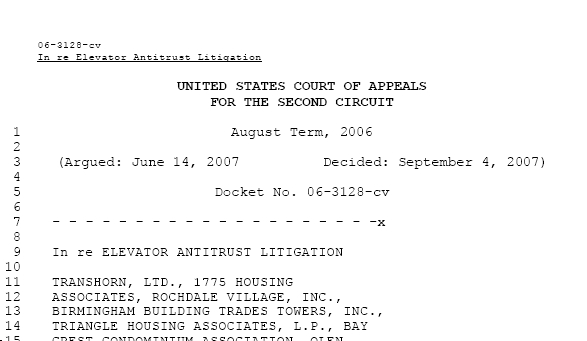
Nicely, the Second Circuit provides the names of Attorneys, something NOT done by some of the other Courts of Appeals.
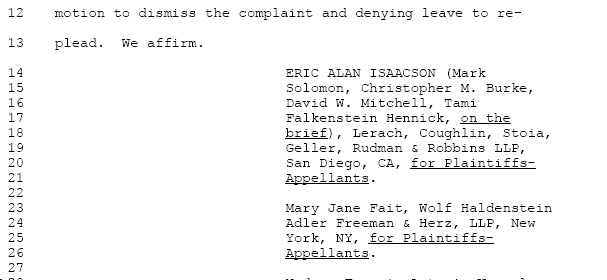
What was also missing in the courtcaption is the information re the docket number and case below - the opinion notes that is is an appeal from a Southern District of New York decision by Judge Griesa, but provides neither the docket number, date, or cite to the case below in the caption. But, by chance, this information is buried on page 7 of the opinion as I discovered later.
So, now armed with the docket number 06-3128-cv, I wanted to checked to see if a docket number search would retrieve the opinion from the opinions page:
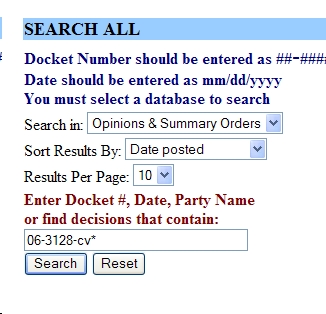
Oh no, this did not work either, even though I am using the exact docket number used by the court in its own search engine:

Perhaps the programmers of the ISYS search engine are not parsing the search for 06-3128-cv, so I decided to search for 06-3128, removing the "cv", since the programmers rely upon user instructions rather than error forgiving software.(Perl hint: $docket-number =~ s/-cv//). I then notice that rather than program the search function by stripping "cv", the web designers provided a warning that the user must only use the digits.

And, Voila, from the Opinions page, the docket number worked.

This is sort of odd since I had initially searched for this particular file in the Docket System by name and did not locate the file.
Next, decided to go off an do some more searching for the missing metadata and in particular information re the case below, so, now armed with the knowledge of the inability of the programmers of the ISYS search to search on file names or even parse the search, I went back to the Dockets page.
Without providing screen-grabs, suffice it to state that all of these searches on the Second Circuit Docket page (as contrasted with the opinions page) failed in the Docket Search: 06-3128, 63128, 06-3128-cv.
I decided to sign into Pacer again, now armed with a Docket number, so I searched for 09-3128 on Pacer:
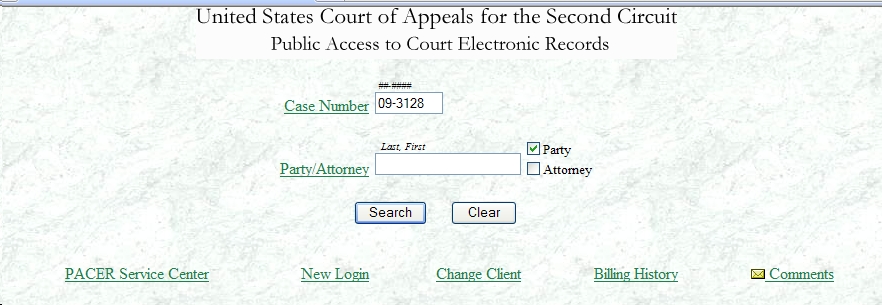

I also searched attorney and party names and could not find the Elevator Antitrust claim - and , each Pacer search cost $.08.
I guess I was doing something wrong here - such as using the Second Circuit Pacer system. I also noted the Judicial Conference press release of last week suggesting that all is going smoothly with ECF/Pacer. [Unlike the situation at the Courts of Appeals, the District Court implementations of ECF must be one of the great examples of a successful implementation of a large scale computerized information system, not only in the Government, but in the private sector].
At this point, I decided to see if the United States Sourthern District systems could help out, so off to the SDNY ECF system. On ECF, nothing turned up for a search on Elevator Antitrust, but a search on the first party named in the appeals case caption: "Transhorn" yielded two possible cases.
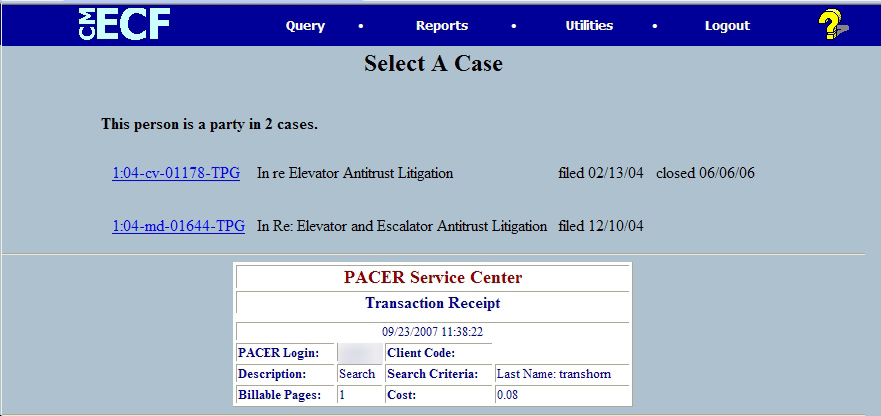
I chose the case that ended in 2006, assuming that would provide an appeal decision in September, 2007. That was the correct case, Now for another $.80 in fees, I retrieved the docket sheet.

I paged down and found the appeal on the docket sheet - but, alors, Judge Greisa's Memorandum of Opinion (DE 90 or Docket Entry 90, circled in blue) signed May 26, 2007 and entered May 30, 2006 (so, what is the date of this opinion), is oddly not filed as an electronic document, although almost all other documents in the case are available electronically.

Alas, the opinions below in our case,: In Re Elevator Litigation, DE 90, Docket. No. 1:04-cv-01178-TPG (United Stated District Court, S.D.N.Y., May 30, 2006) is not available from the court electronically. So, where to find it: first, I could try West's FindLaw, but FindLaw does not provide District Court decisions. Similarly, Lexis One does not provide District Court decisions.
There was another chance perhaps where I could find the opinion free on-line - the Southern Distric twas/ is a participant is something called CourtWeb, which was there way of making decisions available to the public, prior to ECF. So, on the chance that Grisea's opinion was there, I went to CourtWeb and did a search:

As noted in the introduction, the mission of finding the appeals and district court cases evolved into side issues. So, while I was pondering the fact that Judge Grisea's opinion was NOT on ECF, I decided to explore the ECF system and the presentation of district court opinions.
This is not to say that current Southern District of New York opinions are not available to the public: they are available at no cost on the whole if one has an ECF password and knows where to look. But, even there, the Southern District has not complied with the E-Government Act of 2002 since many of the opinions are nor ocr' d and searchable.
But the ECF approach relies upon the Judge marking an order as an opinion to be included in the ECF written opinions reports. There were 15 opinions reported for September 20 and 21, 2007 - more than Lexis had posted two days later. At least most Southern District judges are not marking every order, even one page orders and stipulations, as written opinions, as do many District Courts. But, once again, in this random search, we discover the single page order being marked as a written opinion by a District Court Judge.
Interestingly, in support of the concept of using the docket number and docket entry numbers for citation purposes, in the case In Re: AOL Time Securities, 1:02-cv-05575-SWK, there were two opinions filed on September 20 at DE 305 and 306 - so clearly a cite to date only would present confusion.
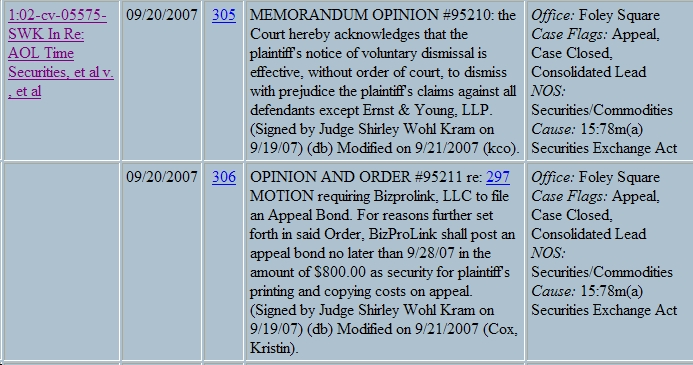
This example is interesting in another way - it is shown as having been filed on September 20, 2007, but then modified on September 21, 2007. So, now I am really confused. Even worse, these are one page orders and should never have been marked as a written opinion for the purposes of the Written Opinions report on ECF.
So, I guess it is time to feed the animals, so off to Lexis. I chose the Federal library, and searched for Elevator Antitrust in the Cite field:
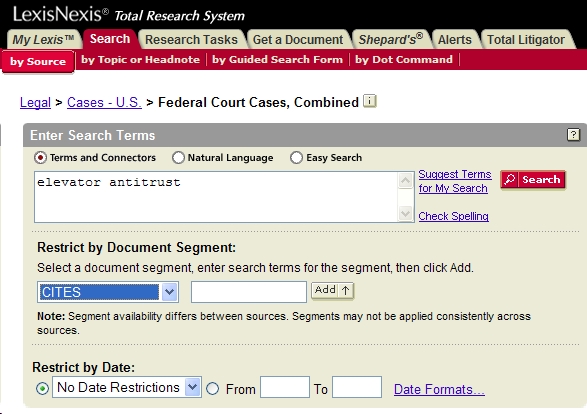
And that retrieved as the first case the Second Circuit opinion I wished to find:
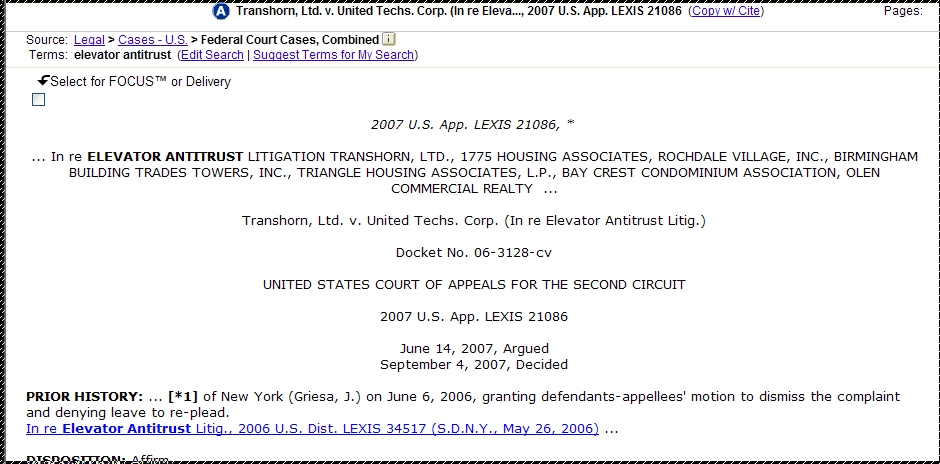
Down at the bottom, we see what all legal professionals would want to see, a link to the case below:
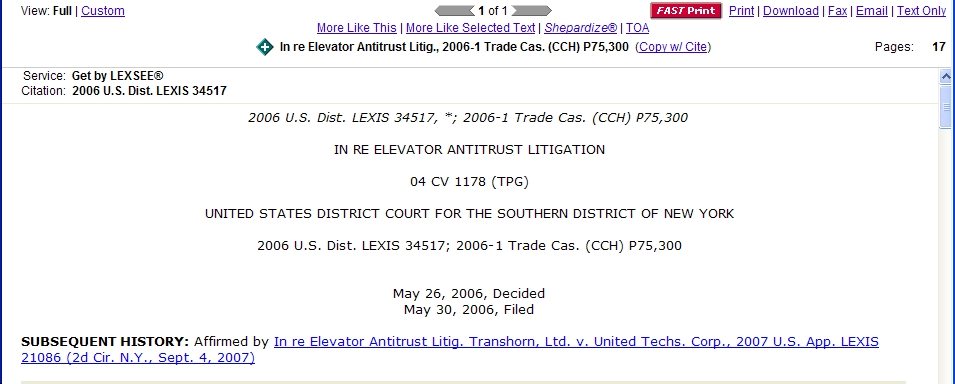 apparently this was a 34 page decision.
apparently this was a 34 page decision.
So, in some way, Lexis was alerted to the fact that Judge Griesa's opinion and was able make it available on Lexis.
The Lexis citation for the case is In Re Elevator Antitrust, 2006 U.S. Dist. LEXIS 34517 (S.D.N.Y.). This is a nicely sanitized version, for the Lexis citation, like the Westlaw citation, conveniently does not include the docket number - so, even if the decision had been in electronic form on the District Court ECF system, it would have been impossible to locate from the Lexis citation, for the simple reason that a search for Elevator Antitrust did not retrieve the case. Why, because, for ECF, the case name required the use of the name Transhorn.
But, first, before finishing this discourse, I decided to Google the case using this search and received this response:
elevator trust

Clicking on Google link, would have taken me directly to the Second Circuit opinion - but, truly by luck, because, embedded in the Second Circuit decision on page 7 is the language that Google linked to. still had not read the Second Circuit opinion in In Re Elevator, for, had I done so, I would have found the District Court information buried. As discussed below, Google did provide search results with the header or caption of the case. As discussed below, adding "Second Circuit" to the search provided the result desired.
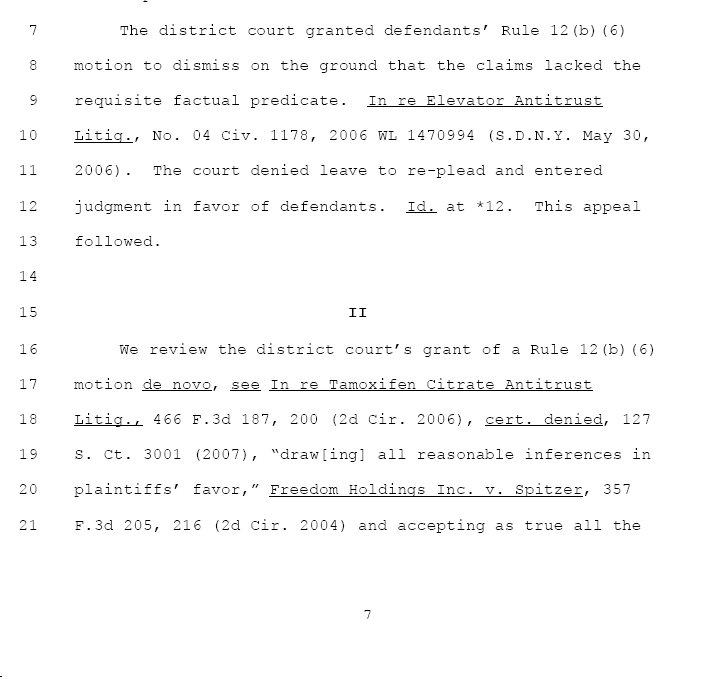
For a little segue from Google, let's observe the citation used by the Second Circuit: "In re Elevator Antitrust Litig., No. 04 Civ. 1178, 2006 WL 1470994 (S.D.N.Y. May 30, 11 2006)." First, the Court did cite to the lower court case's docket number, but only provided a Westlaw citation, not a Lexis citation. Certainly, the Second Circuit should reconsider this citation practice and should also include the Lexis citation. In addition, the docket of the lower court would be essential for non Westlaw and Lexis users (assuming the District Court had the decision on ECF.)
And, finally, Lexis in its citation uses the date the District Court opinion was signed (May 26, 2006), and the court (and perhaps West) uses the date the opinion was entered (May 30,2006).
This, of course calls into question the modes of citing decisions as suggested by the Bluebook and the recent citation format of the Association of Legal Writing Directors with its "AWLD Citation Manual" which is attempting to supplant the Bluebook. AWLD has a special rule 12.12 for "Cases Published Only on LexisNexis or Westlaw" which provides that a proper citation includes:
What is missing from the ALWD's citation - the docket number. Further, it permits either Westlaw or Lexis cites, not both, and finally their is ambiguity as to the date to use. The net result from the ALWD is perpetuation of the Westlaw/Lexis Oligopoly over a public domain immediately available citation based on Docket Number, and, indeed, the citation favors Westlaw since it has the larger market share, which means, there will be more citations to Westlaw than Lexis, leading lawyers to choose Westlaw over Lexis if they need to choose only one provider. The Second Circuit, in the citation under discussion, favors the Westlaw monopoly, but, at least includes the Docket Number.
In our view, the best citation to a U.S. District court decision would included not only the docket number, but the Docket Entry (DE) number, a number uniquely describing the opinion document.
In Re Elevator Litigation, DE 90, Docket. No. 1:04-cv-01178-TPG (United Stated District Court, S.D.N.Y., May 30, 2006)
So, Google had not honed in on the title to the opinion, but indeed to a ctition buried in the text on page 9. But, what did we learn about Google from this:
Finally, before finish this quest, I decided to use the free services LexisOne (owned by Lexis) and FindLaw, owned by West Publishing. Sure enough, the opinion readily appeared by searching on Elevator Antitrust, though not as the first case. But, I knew already that I would not find the District Court case below, so had not first used FindLaw. I knew that Google sometimes crawled FindLaw, so I did a search of FindLaw Antitrust Google, but did not find the text of the case, probably because the file name, 063128p.pdf, was not informative.
Lexis One is also free - and I readily found the opinion by searching "elevator antitrust". But, the Opinions may not be downloaded, unless you print to an Acrobat file or save as an html file. The LexisOne version is not exposed for searching by Google. Interestingly, I found that I could search on LexisOne for the opinion using the Lexis cite: 2007 U.S. App. Lexis 21086 - a nifty trick if you do not have LexisOne. Of course, LexisOne only goes back 5 years, and, like FindLaw, does not present the District Court cases.
That Google does not find this case with a search on "elevator litigation" was odd since a header in the pdf file contains the following information (not all Second Circuit opinions have this header and sometimes the headers refer to cases below - it is too bad the Second Circuit does not use a standardized header with relevant metadata - then Google would cook):
06-3128-cvIndeed, this search did indeed find the case:
In re Elevator Antitrust Litigation
elevator antitrust second circuitSo as did the Google search:
06-3128-cv second circuit
The search above provided an excellent result, se I tried another search for a another docket number::
06-2880 second circuit
This retrieved the alt-law unpublished case. This means that Google is indexing at least some cases on AltLaw.
Then I tried this search
06-4371-cv second circuit
This search retrieved the relevant case at the Second Circuit, as the second ranked item. I then realized that not all Second Circuit cases have a header with the docket nubmer. So, the AltLaw version was not picked up by this search. It is surprising that the Altlaw case was not picked up. Perhaps the case was recently posted and not yet crawled.
Still, the conclusion shows that searching for the docket number and the phrase "second circuit" will retrieve the opinion in a Google search.
Once again, docket numbers belong in citations.
This started out as a simple search - overall, the objective was to locate on the Internet the text of a judicial opinion, based upon limited information. This is generalized into an objective of finding a known case knowing a definitive citation or information about the case. This objective is further generalized into exploring definitive information about judicial opinions which will permit exact location of the opinion on the Internet and to permit a permanent link to the text of the opinion.
After a few of hours at this quest, I still have not studied the opinion, but, my impression is that antitrust enforcement is alive and well in Europe, but less so in the US. But, what killed the plaintiff's case was a conclusory non-factual complaint. See Ross, Dixon, & Bell, LLP, September 21, 2007 Blog, Second Circuit Applies Trinko & Twombly to Close the Door on Antitrust Complaint Against Elevator Companies. I assume that West and Lexis are happy to hear this news.